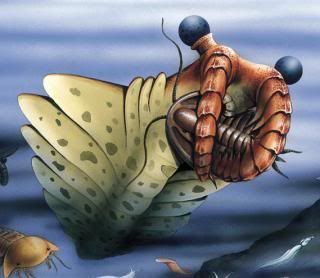Last week I watched Walking With Dinosaurs, and not for the first time since I have memories of seeing it as a child on TV. It's a well-known British documentary made in the early 2000s that got a lot of attention for showing people a modern interpretation of dinosaurs and their kin that the older books and shows of the previous decades had mostly ignored (aside from the very popular Jurassic Park, which while not totally accurate was a good deal better than the old stuff). Together, Jurassic Park and Walking With Dinosaurs helped cement the image of dinosaurs as active, advanced, exciting animals into the public's mind. Before this, the prevailing view was that they were slow, sluggish, and unintelligent animals that died out from being unable to adapt to the world around them. The long-necked sauropods lived in the water and even the meat-eaters were pokey. However, all of those beliefs went out the window when people were finally exposed to the much more accurate findings made by scientists in more recent years. It took fancy computer graphics to get people to understand - even before Jurassic Park, a fantastic book released in the eighties titled The Dinosaur Heresies outlines the case for why the old theories were wrong and what the dinosaurs were really like. It's probably my favorite book on dinosaurs and I recommend it.
So you probably knew about Walking With Dinosaurs, but did you know it received two follow-up films? They were titled Walking With Monsters and Walking With Beasts. Walking With Monsters reviews the evolution of life before the dinosaurs, which began in earnest about 500 million years ago. The ruling predator of the time was the six-foot Anomalocaris, pictured below. It was a creature believed to be split off from the ancestors of modern arthropods (insects, spiders, centipedes, and crabs are examples of arthropods). No modern relatives of this half-billion-year-old creature exist.
Also featured in Walking With Monsters are three-foot-long scorpions, mighty 15-foot predatory fish, and the famous Dimetrodon, a reptile known for the large sail on its back, believed to be used to regulate body temperature.
Walking With Beasts goes into more familiar territory. It focuses on what happened to life on earth after the dinosaurs. For a time, it was as if dinosaurs had never left - one of the first major predators to appear was Gastornis, a giant bird the size of a human that probably behaved much like the famous raptor dinosaurs. In recent years, the theory has been advanced that dinosaurs and birds are so closely intertwined on the family tree that they cannot be properly separated, meaning that birds are a specialized group of dinosaurs that survived the mass extinction 65 million years ago. I may go into more detail about these ideas another time.
Later in the earth's history, the mammals finally took over, establishing themselves as the dominant creatures on earth. The later episodes of Walking With Beasts (it was a six-part miniseries) include spotlights on sabertooth cat and wooly mammoth societies, as well as Australopithecus - an ancestor of the human race. The Australopithecus episode depicts a small tribe of the chimplike animals and their daily trials. The sabertooth episode follows the story of Half-Tooth, a big, strong male who broke one of his sabers in a fight and now manages a pride of sabertooths. The final episode, taking place less than half a million years ago, is the story of Ice Age life, particularly the yearly migration of wooly mammoths as they move south in the fall to avoid the worst of winter.
All of the Walking With films are valuable looks into the past, and are engaging tools for learning more about the history of life on Earth. Just be prepared for some emotional scenes if you connect with animals - nature's constant struggle of predator against prey combined with the occasional natural disaster means multiple creatures die in every episode.

No comments:
Post a Comment